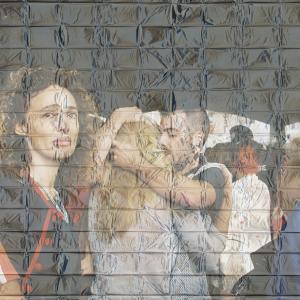We Decked It in Silence
The work was born from the thoughts that accompanied me during the past year, about the terrorist attacks and victims, and about the migration to Europe and the influx of refugees whose pictures filled the news, on TV and on the Internet. The image of the thermal blanket, shining in gold and silver colors, was prominent in these reports against the poverty and misery, the blood and dust.
This dissonance led me to choose the thermal blanket as a leading image in the body of work I created a few months ago and exhibited at Stux Gallery in New York in February-March. There, the blanket as image was used as a juxtaposed, showing/hiding layer, over the base layer of photo images (young recruits and their families), and as a real blanket above the sculpted figure's head in the center of the space, referencing one of the characters in Goya's painting "Flight of the Witches".
While the above exhibit related more to the terrorist attacks that swept the world (including Israel) in the past year, the current installation/performance highlights the notion and experience of being a refugee. The space is filled with a number of bunk beds made of iron, grouped in pairs, forming a kind of habitation cells. The beds are bare, lacking the softening touch and look of mattresses and pillows. They function as an empty skeleton, without any tissue, cold and impersonal. The thermal blanket penetrates the space and beds by means of performers, a small group of men and women dressed in uniform gray, trying through movement and different actions to utilize the blanket to the fullest - to cover, warm up, conceal and hide, and even to create objects, including a boat-shaped object echoing the silver and gold paper boats they produce during the performance and hand over as presents to the viewers.
The concept of home and its reduction to the basic and most simple habitation unit have interested me as an artist from the very beginning, and were reflected in a number of early works like "Home" from 2004, a two meters high, wide and deep cube made of cooked rice, exhibited that same year in Venice; "Hug Me" from 2005, a round alcove made of cooked rice, two meters in diameter and sunk into the ground; "Shelter" from 2009, a kind of house made also of cooked rice and resembled an igloo, exhibited at a Biennale in Portugal and later in Tel Aviv; and "The Other Room" from 2010 that included a bed, desk and chair, all made of cooked rice, exhibited at the Fresh Paint art fair that same year. Therefore, I was deeply touched by the fact that the refugees, who have received temporary asylum in Europe and were housed in different public spaces, joined the bunk beds provided to them together, and created for themselves a place that is allegedly intimate, a kind of temporary house whose walls were improvised by using colorful blankets, providing inside the basic and most primary means of living – sleeping boards matching the number of family members.
Another image that accompanies the current work, as aforementioned, is a paper boat the kind we used to create as children with a simple origami technique. Here it functions as a metaphoric link between the great poverty characteristic of the condition of refugees - the initial organization in the new place that feels like beginning anew, like getting back to the basics, almost to childhood - and the forced and dangerous journey in the sea in rickety boats, a journey so far from those childhood fantasy journeys expressed in the paper boat.


























Comments 0
Say something